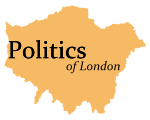 The combined Low Emission Zone and Ultra Low Emission Zone symbol seen on road signs | |
| Location | Greater London |
|---|---|
| Launched | 2008 |
| Technology |
|
| Operator | Capita (from 2015) |
| Manager | Transport for London |
| Currency | GBP |
| Retailed |
|
| Website | Official page |
| This article is part of a series within the Politics of England on the |
| Politics of London |
|---|
 |
The London Low Emission Zone (LEZ) is an area of London in which an emissions standard based charge is applied to non-compliant commercial vehicles. Its aim is to reduce the exhaust emissions of diesel-powered vehicles in London. This scheme should not be confused with the Ultra Low Emission Zone (ULEZ), introduced in April 2019, which applies to all vehicles. Vehicles that do not conform to various emission standards are charged; the others may enter the controlled zone free of charge. The low emission zone started operating on 4 February 2008 with phased introduction of an increasingly stricter regime until 3 January 2012. The scheme is administered by the Transport for London executive agency within the Greater London Authority.
The current standard for large commercial vehicles (over 3.5 tonnes) is Euro VI, increased from Euro IV on 1 March 2021. Vehicles need to meet these standards or face a penalty of £100 per day. The new rules were due to come into force in October 2020 but were postponed due to the 2020 coronavirus pandemic.[1]